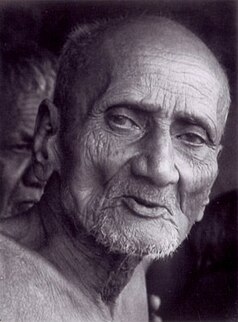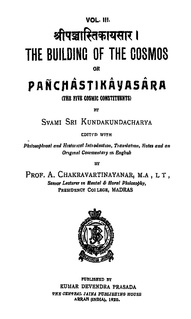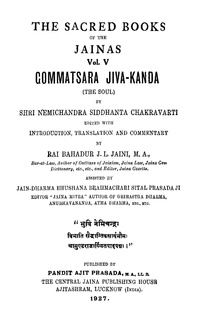
Jainism, traditionally known as Jain Dharma, is an ancient, non-theistic, Indian religion. Followers of Jainism are called "Jains", a word derived from the Sanskrit word jina (victor) and connoting the path of victory in crossing over life's stream of rebirths through an ethical and spiritual life. Jains consider their religion to be eternal (sanatan), and trace their history through a succession of 24 victorious saviours and teachers known as tirthankaras, with the first in current time cycle being Rishabhanatha, who according to Jain tradition lived millions of years ago, twenty-third being Parshvanatha in 8th century BC and twenty-fourth being the Mahāvīra around 500 BCE. Jains believe that Jainism is an eternal dharma with the tirthankaras guiding every cycle of the Jain cosmology.

Acharya Virasena (792-853) was a Digambara monk and belonged to the lineage of Acharya Kundakunda. He was an Indian mathematician and Jain philosopher and scholar. He was also known as a famous orator and an accomplished poet. His most reputed work is the Jain treatise Dhavala. The late Dr. Hiralal Jain places the completion of this treatise in 816 AD.

Acharya Shri Shantisagar (1872–1955) was an Indian monk of the Digambara school of the Jain faith. He was the first Acharya (preceptor) and a leader of his sect in the 20th century. Shantisagar revived the teaching and practice of traditional Digambara practices in North India.

Jain meditation (dhyāna) has been the central practice of spirituality in Jainism along with the Three Jewels. Jainism holds that emancipation can only be achieved through Meditation or Shukla Dhyana. According to Sagarmal Jain, it aims to reach and remain in a state of "pure-self awareness or knowership." Meditation is also seen as realizing the self, taking the soul to complete freedom, beyond any craving, aversion and/or attachment. The practitioner strives to be just a knower-seer (Gyata-Drashta). Jain meditation can be broadly categorized to the auspicious and inauspicious. The 20th century saw the development and spread of new modernist forms of Jain Dhyana, mainly by monks and laypersons of Śvētāmbara Jainism.

Ṣaṭkhaṅḍāgama, literally the "Scripture in Six Parts", is the foremost and oldest Digambara Jain sacred text. According to Digambara tradition, the original canonical scriptures of the Jains were totally lost within a few centuries of Nirvana of Lord Mahavira. Hence, Satkhandāgama is the most revered Digambara text that has been given the status of āgama. The importance of the Satkhandāgama to the Digambaras can be judged by the fact that, the day its Dhavalā commentary was completed, it is commemorated as Shruta Pañcami, a day when all the Jaina scriptures are venerated. Satkhandāgama, the first āgama is also called the Pratham Shrut-Skandh, while the Panch Paramāgama by Acharya Kundakunda are referred to as the second āgama or Dvitiya Shrut-Skandh.

Samayasāra is a famous Jain text composed by Acharya Kundakunda in 439 verses. Its ten chapters discuss the nature of Jīva, its attachment to Karma and Moksha (liberation). Samayasāra expounds the Jain concepts like Karma, Asrava, Bandha (Bondage), Samvara (stoppage), Nirjara (shedding) and Moksha.

Pañcastikayasara, is an ancient Jain text authored by Acharya Kundakunda. Kundakunda explains the Jain concepts of dravya (substance) and Ethics. The work serves as a brief version of the Jaina philosophy. There are total 180 verses written in Prakrit language. The text is about five (panch) āstikāya, substances that have both characteristics, viz. existence as well as body.
Jain philosophy is the oldest Indian philosophy that separates body (matter) from the soul (consciousness) completely. Jain philosophy deals with reality, cosmology, epistemology and Vitalism. It attempts to explain the rationale of being and existence, the nature of the Universe and its constituents, the nature of soul's bondage with body and the means to achieve liberation.

Sanskrit moksha or Prakrit mokkha refers to the liberation or salvation of a soul from saṃsāra, the cycle of birth and death. It is a blissful state of existence of a soul, attained after the destruction of all karmic bonds. A liberated soul is said to have attained its true and pristine nature of infinite bliss, infinite knowledge and infinite perception. Such a soul is called siddha and is revered in Jainism.
Mulachara is a Jain text composed by Acharya Vattakera of the Digambara tradition, around 150 CE. It incorporates the concepts derived from the Acharanga Jain Agama, the original of which is now regarded to be lost in the Digambara tradition.

Guṇasthāna are the fourteen stages of spiritual development and growth through which a soul gradually passes before it attains moksha (liberation). According to Jainism, it is a state of soul from a complete dependence on karma to the state of complete dissociation from it. Here the word virtue does not mean an ordinary moral quality, but it stands for the nature of soul — knowledge, belief and conduct.
The Jīva or Atman is a philosophical term used within Jainism to identify the soul. As per the Jain cosmology, jīva or soul is the principle of sentience and is one of the tattvas or one of the fundamental substances forming part of the universe. The Jain metaphysics, states Jagmanderlal Jaini, divides the universe into two independent, everlasting, co-existing and uncreated categories called the jiva (soul) and the ajiva (non-soul). This basic premise of Jainism makes it a dualistic philosophy. The jiva, according to Jainism, is an essential part of how the process of karma, rebirth and the process of liberation from rebirth works.

Aacharya Umaswami, also known as Umaswati, was an early 1st-millennium Indian scholar, possibly between 2nd-century and 5th-century CE, known for his foundational writings on Jainism. He authored the Jain text Tattvartha Sutra. Umaswati's work was the first Sanskrit language text on Jain philosophy, and is the earliest extant comprehensive Jain philosophy text accepted as authoritative by all four Jain traditions. His text has the same importance in Jainism as Vedanta Sutras and Yogasutras have in Hinduism.

Pravachanasara, is a text composed by Jain monk, Kundakunda, in about the mid-second century BC. It means "Essence of Scriptures" or "Essence of Sermons" or "Essence of Doctrine". In the text, Kundakunda shows how the correct understanding of the duality of self and others leads to that defining characteristic of Digambara mendicant praxis, nudity. It consists of three chapters and 275 verses.

Gommatsāra is one of the most important Jain texts authored by Acharya Nemichandra Siddhanta Chakravarti.
Jayasena was a twelfth century Digambara Jain Acharya who wrote Tattparyavritti, a commentary on Acharya Kundakunda's Pravachanasara.
Vattakera was a first century CE Digambara Jain Acharya who wrote Mulachara around 150 CE.
Padmanabh Shrivarma Jaini is an Indian born scholar of Jainism and Buddhism, currently living in Berkeley, California, United States. He is from a Digambar Jain family; however he is equally familiar with both the Digambara and Svetambara forms of Jainism. He has taught at the Banaras Hindu University, the School of Oriental and African Studies (SOAS), the University of Michigan at Ann Arbor and at the University of California at Berkeley, from which he retired in 1994. Professor Jaini is the author of several books and papers. His best known work is The Jaina Path of Purification (1979). Some of his major articles have been published under these titles: The Collected Papers on Jaina Studies (2000) and Collected Papers on Buddhist Studies (2001).

University of California Press, otherwise known as UC Press, is a publishing house associated with the University of California that engages in academic publishing. It was founded in 1893 to publish books and papers for the faculty of the University of California, established 25 years earlier in 1868. Its headquarters are located in Oakland, California.

The International Standard Book Number (ISBN) is a numeric commercial book identifier which is intended to be unique. Publishers purchase ISBNs from an affiliate of the International ISBN Agency.



















